Like Happiness, Commodities Diversification Comes From Within
September 23, 2022
Executive Summary:
Investors should take advantage of sector dispersion within the commodities asset class by doing the following:
- Be diversified and know what you own – When choosing a diversified option investors should understand structural biases within the products that they choose. For example, understanding if there are sufficient guardrails to prevent the product from loading up on one commodity sector and essentially becoming a “commodity focused” product in disguise.
- Be Dynamic - Choose diversified commodity solutions that can rebalance and reconstitute more frequently than other passive offerings.
Diversification Within the Asset Class May Be as Important as the Diversification Benefits Across Asset Classes:
Goldman Sachs Global Investment Research Group just released their total return forecasts for two widely known commodities indices, the Bloomberg Commodities Index (BCOM) and the Goldman Sachs Commodity Index (GSCI). As you can see in the tables below, the forecasts, while both positive over 3, 6 and 12 months, vary considerably in absolute terms between the two benchmarks. This could prompt the logical question from investors of “how could two broadly diversified commodities indices have such divergent expected returns?” The answer, of course, is that the sector weighting differences as well as the sub-sector differences (natural gas, gasoil, West Texas Intermediate (WTI), etc. within Energy, for example) have a significant impact on the resultant return forecast differences.
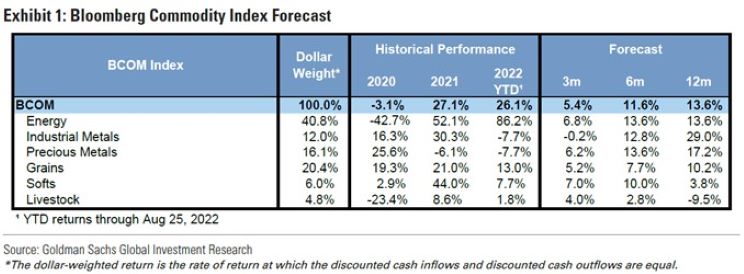
Past performance is not indicative of future results.
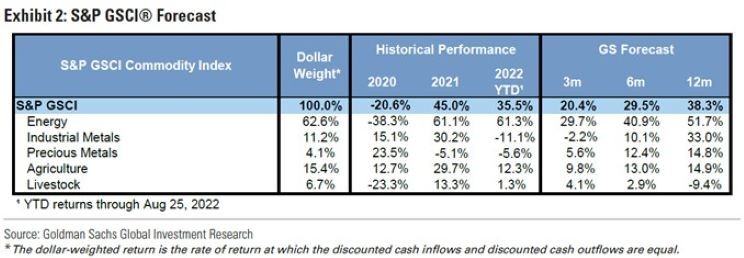
Past performance is not indicative of future results.
This, however, also highlights that while commodities represent one asset class, their component parts have typically featured meaningful dispersion in their historical performance patterns. For example, the chart below shows the rolling 12-month total returns of each of the main sectors within the overall GSCI Index; Energy, Precious Metals, Industrial Metals, Agriculture, and Livestock. Not only has the dispersion between sectors been high, but it has also been quite common to observe negative correlation among sector returns over time (one positive, one negative). This is before even considering the even greater performance differences that can occur between various sub-sectors (like Grains and Softs within Agriculture) or between specific commodities (like natural gas and crude oil).
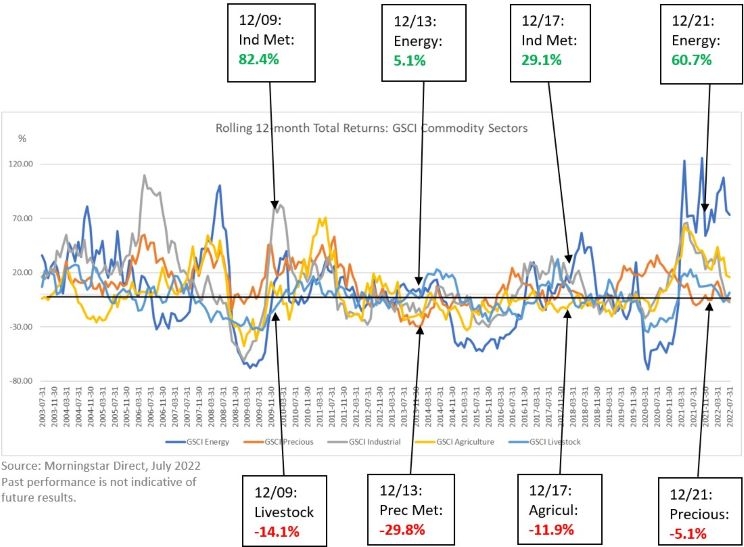
In addition, this sector dispersion1 within commodities has been meaningfully higher than the sector dispersion experienced within equities historically. For example, when you look at cross-sector volatility (see chart below) for commodities since the beginning of 2012, as measured by the standard deviation2 among sector 12-month rolling returns, it has been more than 50% higher than the cross-sector volatility among equities (when measuring the standard deviation of returns across equity sectors like Health Care, Tech, Consumer Staples, etc.).
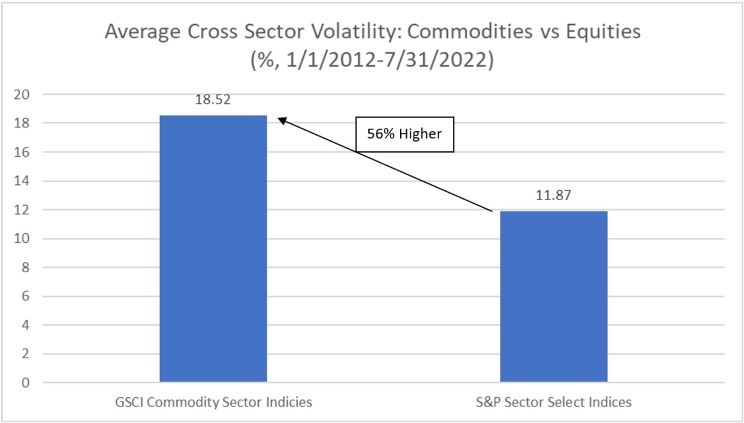
Source: Morningstar Direct, July 2022
This, we believe, highlights an important diversification benefit within the commodities asset class that may not be fully appreciated by investors. We find that many investors are either (rightly) focused on the diversification benefits that commodities bring to a broader portfolio of stocks and bonds or are those that allocate to specific commodities or subsectors (like gold or energy ETFs), which sacrifices intra-commodity diversification benefits and can be easily prone to mistiming. For example, since the beginning of 2019 through July 2022, the Commodity Focused category of mutual funds and ETFs took in more than 2x the amount of flows as the Commodity Broad Based category ($39B vs $16B) (Morningstar Direct, July 2022). In addition, many gold-focused products took in substantial net inflows during 2020, only to disappoint investors in 2021 as the precious metals sector represented the sole sector within the broader GSCI index to post a negative return.
Lastly, we’ve observed that cross sector dispersion among commodities has been elevated/rising since the end of 2018 likely as a result of more frequent supply/demand disruptions from the pandemic and geopolitical unrest (see the following chart). This, in our view, further highlights the importance for investors to be properly diversified within the commodities asset class in the current environment.
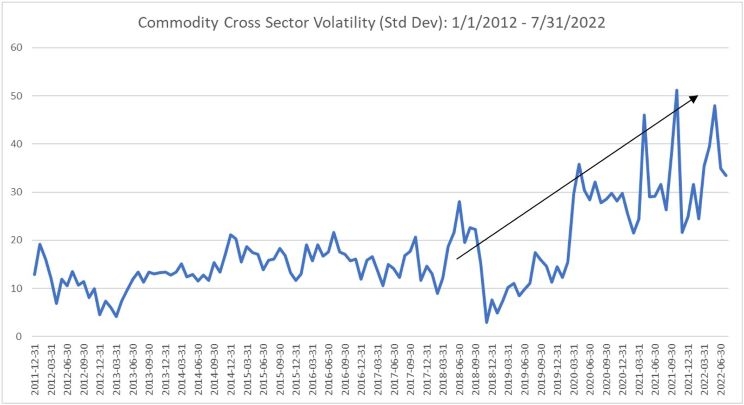
Source: Morningstar Direct, June 2022
So how should investors take advantage of this sector dispersion within the commodities asset class? One suggestion would be to “be diversified and know what you own”. In our view, this is not an appropriate asset class for the majority of DIY investors to invest in single sector or single commodity products like energy or gold ETFs, for example. Equally important, however, to choosing a diversified option is for investors to understand structural biases within the products that they choose. For example, are there sufficient guardrails to prevent the product from loading up on one commodity sector and becoming essentially a “commodity focused” product?
Another suggestion would be for investors to “be dynamic”. Not overly so, as commodity markets can quickly whipsaw investors for reasons beyond fundamentals. For example, strategic reserve releases, wars or potential IRAN/U.S. oil nuclear deals. But be dynamic in the sense of choosing diversified commodity solutions that can rebalance or reconstitute more frequently than many passive offerings. The Harbor All Weather Inflation Focus ETF (HGER) can be an example of this, as it rebalances its commodity weights quarterly, as opposed to other products that typically rebalance annually.
Important Information
1 Dispersion refers to a statistical measure of the range of potential outcomes for an investment based on its historical volatility or returns.
2 Standard deviation measures the dispersion of a dataset relative to its mean.
The views expressed herein are those of Harbor Capital Advisors, Inc. investment professionals. They may not be reflective of current opinions, are subject to change without prior notice, and should not be considered investment advice.
Investing involves risk, principal loss is possible. Unlike mutual funds, ETFs may trade at a premium or discount to their net asset value. The ETF is new and has limited operating history to judge.
Shares are bought and sold at market price not net asset value (NAV). A fund’s NAV is the sum of all its assets less any liabilities, divided by the number of shares outstanding. Market price returns are based upon the closing composite market price and do not represent the returns you would receive if you traded shares at other times.
There is no guarantee that the investment objective of the Fund will be achieved. Stock markets are volatile and equity values can decline significantly in response to adverse issuer, political, regulatory, market and economic conditions. A non-diversified Fund may invest a greater percentage of its assets in securities of a single issuer, and/or invest in a relatively small number of issuers, it is more susceptible to risks associated with a single economic, political or regulatory occurrence than a more diversified portfolio.
Commodity Risk: The Fund has exposure to commodities through its and/or the Subsidiary’s investments in commodity-linked derivative instruments. Authorized Participant Concentration/Trading Risk: Only authorized participants (“APs”) may engage in creation or redemption transactions directly with the Fund. Commodity-Linked Derivatives Risk: The Fund’s investments in commodity-linked derivative instruments (either directly or through the Subsidiary) and the tracking of an Index comprised of commodity futures may subject the Fund to significantly greater volatility than investments in traditional securities.
The Quantix Inflation Index is calculated on a total return basis, which combines the returns of the futures contracts with the returns on cash collateral invested in 13-week U.S. Treasury Bills. This unmanaged index does not reflect fees and expenses and is not available for direct investment. The Quantix Inflation Index was developed by Quantix Commodities LP and is owned by Quantix Commodities Indices LLC.
Diversification does not assure a profit or protect against loss in a declining market.
The Bloomberg Commodity Index (BCOM) is a broadly diversified commodity price index distributed by Bloomberg Index Services Limited. It is calculated on an excess return basis and reflects commodity futures price movements. The index rebalances annually weighted 2/3 by trading volume and 1/3 by world production and weight-caps are applied at the commodity, sector and group level for diversification. Roll period typically occurs from 6th-10th business day based on the roll schedule.
The S&P GSCI is a composite index of commodities that measures the performance of the commodities market. The index often serves as a benchmark for commodities investments.
Quantix Commodities LP (“Quantix”) is a third-party subadvisor to the Harbor All-Weather Inflation Focus ETF.
Foreside Fund Services, LLC is the Distributor of the Harbor All-Weather Inflation Focus ETF.
2472036
